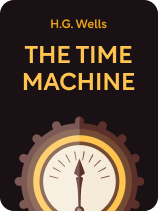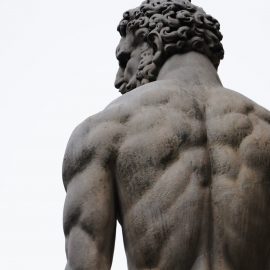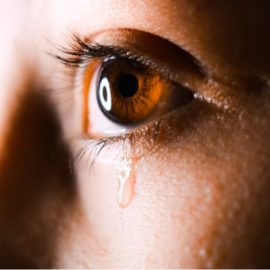

This article is an excerpt from the Shortform book guide to "The Time Machine" by H.G. Wells. Shortform has the world's best summaries and analyses of books you should be reading.
Like this article? Sign up for a free trial here.
What year does the Time Traveller in The Time Machine travel to? What does he find when he arrives?
H.G. Wells’s classic book The Time Machine, first published in 1895, is one of the earliest known science fiction stories. It popularized the concept of time travel and introduced the now-common phrase “time machine.”
Continue reading for a synopsis of The Time Machine by H.G. Wells.
Synopsis of The Time Machine
In the book The Time Machine, a Victorian scientist builds a machine that can travel through time. In the distant future he finds that, rather than advancing, human civilization has totally collapsed. This literary classic has also gotten two movie adaptations (one from 1960 and the other from 2002) showing that H.G. Wells’s story still captures people’s imaginations over 100 years later.
Herbert George Wells, better known by his pen name H.G. Wells, was one of the most popular writers of the early 1900s. Though he’s best known today for his science fiction stories—including The Time Machine and The War of the Worlds—Wells was a prolific and influential author across a wide variety of genres. His works range from satirical short stories and historical novels to formal essays on socialism.
This synopsis of The Time Machine organizes the book into four key sections:
- Exposition: The Time Traveller, an unnamed scientist from the Victorian era (19th-century England), shows off his time machine to a group of friends and explains how time travel is possible.
- A.D. 802701: The Time Traveller goes to the distant future, where he finds that humanity has evolved into two separate species—the childlike Eloi and the bestial Morlocks.
- The End of the World: The Time Traveller escapes from A.D. 802701 and goes even farther into the future, to a time when life on Earth has almost completely died out.
- Conclusion: The Time Traveller briefly returns to the present to tell his friends about his adventures. He then leaves on another journey through time—one from which he never returns.
Exposition: Time Is the Fourth Dimension
The Time Machine begins with the Time Traveller explaining to a group of his friends (including the narrator) that time travel is possible. This is because time is a dimension just like length, width, and height. Furthermore, people should be able to move through time just as they can move through the other three dimensions.
To prove this, the Time Traveller says that nothing could be only three-dimensional, because an object that exists for zero time doesn’t exist at all. He illustrates the point by comparing it to the fact that no object can truly be two-dimensional—anything that exists must have some height, even if it’s as thin as a sheet of paper. Therefore, all objects actually exist in four dimensions (length, width, height, and time).
The Time Traveller then announces that he’s created a machine that can move freely through the fourth dimension, which he shows to his disbelieving guests. After a short demonstration involving a miniature version of the time machine, the guests go home.
One week later, the guests return to the Time Traveller’s house for a dinner party. The Time Traveller isn’t there, but the guests find a note saying to start eating. The group is in the middle of their meal when the Time Traveller returns; the guests are shocked to see that he’s filthy and limping. After dinner, the Time Traveller tells them what he experienced when he traveled through time.
The World of A.D. 802701
The Time Traveller’s story begins at 10 o’clock that morning (the day of the dinner party), when he finishes his preparations and makes his first journey through time. The Time Traveller goes as far into the future as he dares and lands in the year A.D. 802701.
We’ll examine the Time Traveller’s adventures in A.D. 802701. It starts by explaining how he meets the peaceful Eloi and begins exploring their world, then discusses his encounters with the dangerous Morlocks.
Meeting the Eloi
The Time Traveller lands in a garden, near a statue of a sphinx on a bronze pedestal. He soon meets a group of people called the Eloi, who appear to be distant descendants of humans. The Time Traveller mentions that the Eloi are beautiful to look at, but says that they have a number of strange features.
The Eloi are only about four feet tall and very slender, with little muscle. There are no physical differences between males and females, and the only difference between children and adults is their height. There are also no signs of disease among the Eloi population, and none of them seem to have jobs.
The Eloi show no fear of the Time Traveller, even though he’s a large (to them) and strange being who suddenly appeared among them. Instead of running away or attacking, they feed him fruit and try to teach him their language.
However, the Time Traveller senses that the Eloi aren’t very smart, contrary to his assumption that people in the future would be advanced and intelligent. He hypothesizes that the lack of hardship over many generations has made them this way—without any challenges to overcome, the Eloi have no need for physical strength or intelligence.
The Eloi are also apathetic: When one of them—a female named Weena—falls into a river, none of her companions try to help, so the Time Traveller jumps in to save her. Weena becomes attached to him after that and follows him for the rest of his time in A.D. 802701.
Exploring the Future
The Time Traveller removes the control levers from his machine so that nobody else can use it, then goes out to explore the world of A.D. 802701. He notes numerous ruins around the landscape, while the only intact buildings are large structures that remind him of palaces. There are no homes for individual families, which makes him think of communism; many families live together in large, shared homes.
As night falls, the Time Traveller goes back to where he left the time machine and finds that it’s not there. He wakes a group of sleeping Eloi and demands to know what they did with his machine, but they seem confused and—for the first time—afraid. He later learns that the Eloi are terrified of the dark.
The next morning, the Time Traveller notices marks in the grass and deduces that someone dragged his machine inside the pedestal of the nearby sphinx statue, which must therefore be hollow. He asks the Eloi how to open the pedestal, but they’re shocked and appalled at the question. The Time Traveller decides he’ll have to learn more about the Eloi and their world to figure out how to get his time machine back.
Meeting the Morlocks
As the Time Traveller continues to explore, he notices numerous large holes, resembling wells, going deep into the ground. He finds that the wells are part of an enormous mechanical ventilation system that’s pulling air underground.
On his fourth day in the future, the Time Traveller takes shelter in one of the many ruins. Inside it, he encounters a strange, pale, ape-like creature, larger than an Eloi though still smaller than a human. The creature immediately runs away from him. He tries to follow, but it climbs down one of the wells and disappears.
Thinking about everything he has seen since arriving in A.D. 802701, the Time Traveller concludes that humans have evolved into two species: the surface-dwelling Eloi and this subterranean race, whom he learns are called Morlocks.
The Time Traveller further hypothesizes that these two species are the end result of the division between the upper class and the working class—a division that’s present and widening even in his own time. He muses that the rich must have forced the poor to live underground but to keep working for them. In other words, the idyllic surface world could only exist because of the mass exploitation of the working class.
Descending Into the Morlocks’ World
The Time Traveller is now certain that the Morlocks, not the Eloi, hid his machine (remember that the Eloi were shocked at the idea of opening the pedestal). Therefore, he decides that getting back to his own time will require going down into the Morlocks’ world to learn more about them.
The Time Traveller tries to climb down one of the wells, but when he stops to rest, Morlocks swarm and try to grab him. He lights a match so he can see his attackers, and the light scares the Morlocks away.
The Time Traveller then follows the fleeing Morlocks to a huge chamber. Inside the chamber is a table with a large hunk of meat on it. He reasons that it must be Eloi meat, since he hasn’t seen any farm animals either on the surface or underground.
The Time Traveller now understands that, while the Eloi might be the descendants of a wealthy ruling class, they’re now essentially well-kept livestock. In other words, the Morlocks continue to make clothes for the Eloi and see to their needs, while also using them as a food source.
Using the rest of his matches to keep the Morlocks at bay, the Time Traveller narrowly escapes and climbs back to the surface.
Escaping From A.D. 802701
The Time Traveller continues to explore and finds several useful items. Inside the ruins of a museum, he breaks a large metal lever off of an old machine to use as a weapon. Then, in a library filled with decayed books, he finds a box of matches and a jar of camphor (a chemical compound that burns quickly and brightly).
At this point the Time Traveller decides to go back to the garden, hoping that he can use the lever to break open the pedestal and get his machine back. However, the Morlocks pursue him and Weena, eventually surrounding them and trapping them in the woods. The Time Traveller builds a fire to keep the Morlocks away, and he and Weena fall asleep.
The Morlocks attack during the night despite the fire. The Time Traveller kills several of them with the broken lever, and the rest run away. He then realizes that the fire he started has spread to the surrounding trees, and Weena has disappeared, so he runs alone out of the woods to safety.
Once the sun rises the Time Traveller searches for Weena again. However, he still can’t find her, and he concludes that she must have died in the fire. He’s briefly tempted to kill the Morlocks—who are helpless because of the light and heat from the forest fire—but decides against it.
When the Time Traveller makes it back to the garden he’d first arrived in, he’s surprised to see that the statue’s pedestal is already open. He knows it must be a Morlock trap, but he goes inside anyway since that’s the only way to get back to his time machine. The Morlocks attack as he expects, but he manages to fight through them, reattach the control levers for the time machine, and escape further into the future.
The End of the World
In his escape from the Morlocks, the Time Traveller leaps many millennia into the future. Watching from inside his time machine, he sees that the sun is getting bigger and redder as he travels, and the Earth is turning more and more slowly.
He finally stops the machine at an unspecified time in the distant future. The Time Traveller finds himself in a world of lush plants and enormous animals but sees nothing humanoid.
After that stop, the Time Traveller continues into the future. He begins briefly stopping every thousand years to study his surroundings. There are fewer plants and animals each time he stops, and the Time Traveller concludes that the entire Earth is slowly dying.
Finally, about 30 million years into the future, he stops for a longer time to observe the state of the world more closely. The air in this time period is thin and extremely cold. The sun is now fully red and takes up a large section of the sky.
The Time Traveller sees nothing living except for some mosses and lichens, and a creature that looks like a black octopus roughly the size of a soccer ball flopping weakly in the ocean shallows. It begins to snow, then the sky turns dark and he realizes he’s seeing a solar eclipse.
The Time Traveller is horrified and sickened by this bleak view of the end of the world. Eventually the eclipse ends, and the returning light brings the Time Traveller to his senses. He returns to his machine and starts the journey back to his own time.
Conclusion: Returning to the Present
The Time Traveller lands his machine on the same date he’d started from, at about eight o’clock in the evening. He hears the sounds of the dinner party happening just outside his laboratory, so he greets his guests, cleans himself up, and joins them.
The Time Traveller tells the dinner guests about his journey through time and adds that he doesn’t expect them to believe him. So, as evidence of his travels, he places two strange white flowers—a gift from Weena—on the table. He also points out that the time machine is stained with dirt and grass, which would be impossible had it never left his laboratory.
The guests eventually leave, deep in discussion about what he told them. The narrator can’t sleep that night, and the next day he returns to the Time Traveller’s house uninvited. He finds the Time Traveller getting ready for another journey through time. The Time Traveller says he’ll be back in half an hour, and this time he’ll bring conclusive proof that his story was true.
The story ends with the narrator explaining that three years have passed since that day. The Time Traveller never returned, and the narrator now thinks that he never will. He wonders whether the Time Traveller is still wandering through time or if he died during his travels.
Furthermore, the narrator is still deeply upset by what he’d heard about the end of humanity and, later, the end of the world. His only comfort is the two flowers from Weena, which he kept for himself after the Time Traveller left on his second journey. To the narrator, the flowers symbolize the fact that people will always have the capacity for love and gratitude, even after they’ve lost everything else that makes them human.
Exercise: Analyze The Time Machine
Reflect on Wells’s key ideas and how he presents them. Are the themes of societal collapse and existential dread still relevant today? Does the Time Traveller’s story provide a valid solution?
- What present-day trends, if any, seem to be leading toward the future that Wells’s Time Traveller saw? For instance, is the divide between the upper class and the working class as extreme or harmful as Wells makes it out to be? Does it seem as though humans are heading for societal collapse and extinction?
- Conversely, what present-day trends make the future presented in The Time Machine seem unlikely?
- A lot of The Time Machine’s emotional impact relies on the Time Traveller’s assumption that the Eloi and Morlocks both evolved from humans. Does his idea seem plausible? Why or why not?
- What do you think the world will be like in the distant future? For example, do you think humans will populate Earth, and will they be recognizable as human? What might technology and culture be like? Alternatively, if you think humans will go extinct, what might the world look like after we’re gone?

———End of Preview———
Like what you just read? Read the rest of the world's best book summary and analysis of H.G. Wells's "The Time Machine" at Shortform.
Here's what you'll find in our full The Time Machine summary:
- An overview and analysis of H.G. Wells's 1895 science fiction novel
- A look at the science behind the story—what's real and what's fiction
- The literary techniques and symbolism Wells used to craft the story






